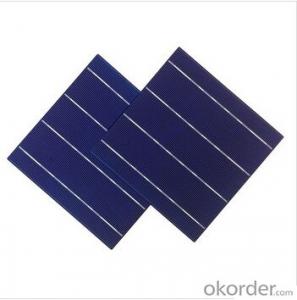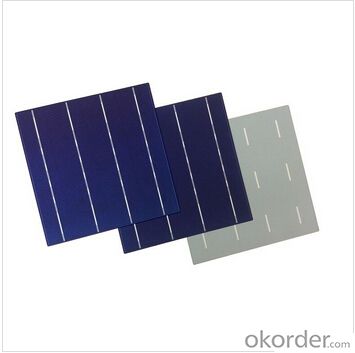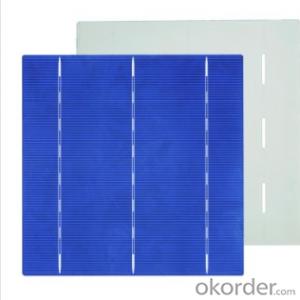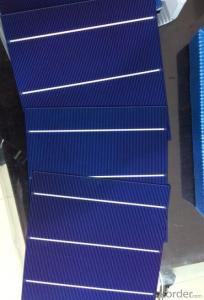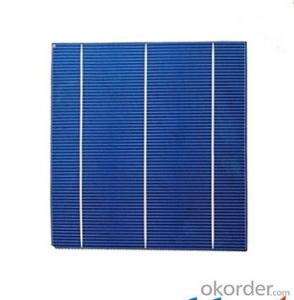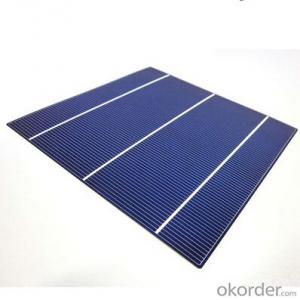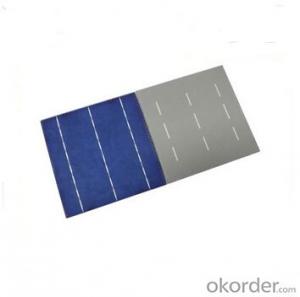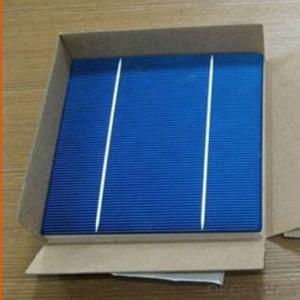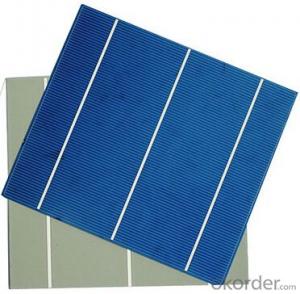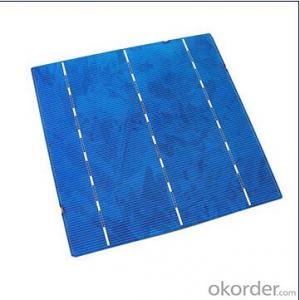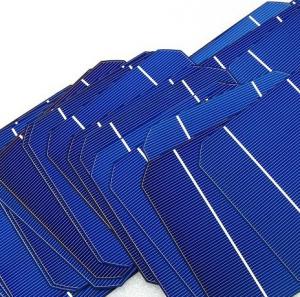High Quality 17.2% Polycrystalline Solar Cells for Space Applications
- Loading Port:
- Shanghai
- Payment Terms:
- TT OR LC
- Min Order Qty:
- 1000 pc
- Supply Capability:
- 1000000 pc/month
OKorder Service Pledge
OKorder Financial Service
You Might Also Like
Solar Cells:
solar cells, when struck by photons of light from the sun, generates an electrical current which can then be used to power DC or AC electrical loads.
A solar cell is made of silicon. Computer chips are made of this same material. Basically, when light strikes the surface of a solar cell some of it is absorbed into the silicon. This light energy bumps the electrons loose and causes energy to flow
Solar cells is made by solar wafer, it has three categories of solar cell right now, monocrystalline polycrystalline and thin film,These cells are entirely based around the concept of PN junction, which is the critical part of solar module, it is the part that can convert the light energy into electricity, the thickness is from 180um to 200um, with even busbars to conduct electricity, textured cell can decrease diffuse reflection; they are often electrically connected and encapsulated as a module. Photovoltaic modules often have a sheet of glass on the front (sun up) side, allowing light to pass while protecting semiconductor wafers from abrasion and impact due to wind-driven debris, rain, hail, etc. Solar cells are also usually connected in series in modules, creating an additive voltage. Connecting cells in parallel will yield a higher current;With high quality and stable quality. Our Cells can greatly improve the performance of Solar Modules.
Features:
High efficiencies up to 16.4%
Proven long term mechanical stability of silicone
Make of highly purified poly silicone
Three bus bars for reduced series resistance and improved module and cell efficiency
Blue anti-reflecting coating ensures improved light absorption and increased efficiency
Acid texturization offers a uniform appearance and virtually invisible crystal structure
Excellent low light behavior for improved energy yield
Specifications
Product Construction: | Epoxy Resin + Cell + PCB |
Maximum Output: | 4w |
Tolerance: | ±3% |
Maximum Output Power (Wmp) | 4w |
Max Working Voltage (Vmp) | 6v |
Max Charging Current (Imp) | 665ma |
Open Circuit Voltage (Voc) | 7.44v |
Short Circuit Current (Isc) | 720ma |
Cell efficiency(η): | 17.2% or above |
PCB | FR-4 |
PCB thickness(mm) | 1.6mm |
PCB color | Black |
PCB size(mm) | 165*165*2.7mm |
Product thickness: | 2.7mm |
Net Weight | 130g |
Barline: | Black tape or none |
Lifetime: | 1-3 years |
Storing temperature | 20°C ~ 60°C |
Working temperature | -20°C ~ 60°C |
Solar Cells Advantage:
1. High efficiency and High power.
2. Long-term electrical stability.
3. Lowest price and Fastest delivery.
4. Good quality and good service.
5.Bulk supply
6. Good Warranty
7.Big Sale
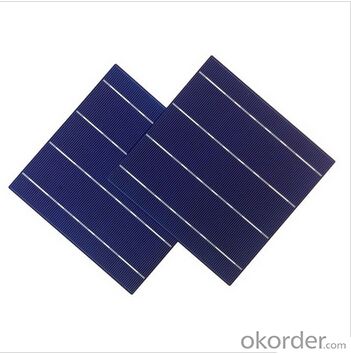
FAQ
We have organized several common questions for our clients,may help you sincerely:
①What price for each watt?
It depends on the efficiency of the solar cell, quantity, delivery date and payment terms.
②How long can we receive the product after purchase?
In the purchase of product within three working days, We will arrange the factory delivery as soon as possible. The pecific time of receiving is related to the state and position of customers.Commonly 7 to 10 working days can be served.
③Can you provide the peripheral products of the solar panels, such as the battery, controller, and inverter? If so, can you tell me how do they match each other?
Yes, we can, we have two companies for solar region, one is CNBM International, the other is CNBM engineering Co.
We can provide you not only the solar module but also the off grid solar system, we can also provide you service with on grid plant.
④What is your warranty of solar cell?
Our product can promise lower than 0.3% open box crack, we support claim after opening the box if it has crackm color difference or sth, the buyer should give pictures immediately, we can not accept the claim after the solar cell has assembled to solar panel.
• Timeliness of delivery
• ⑤How do you pack your products?
We have rich experience on how to pack the solar cell to make sure the safety on shipment, we could use wooden box or pallet as buyer's preference.
- Q: What is the efficiency of solar cells?
- The efficiency of solar cells refers to the percentage of sunlight that can be converted into usable electricity. It varies depending on the type of solar cell technology used, but current commercial solar cells typically have an efficiency range of 15% to 22%. However, research and development efforts are continuously improving solar cell efficiency, with some laboratory prototypes achieving efficiencies exceeding 40%.
- Q: Can solar cells be used for powering space missions?
- Yes, solar cells can be used for powering space missions. Solar cells convert sunlight into electricity, providing a reliable and sustainable power source for space exploration. They have been extensively used on spacecraft and satellites to generate electricity for various systems and instruments.
- Q: Can solar cells be used in military applications?
- Yes, solar cells can be used in military applications. They have various applications in the military, including powering remote surveillance systems, communication equipment, and providing electricity to field operations in remote areas. Solar cells offer a reliable and sustainable source of energy, reducing the reliance on traditional fuel sources and enhancing the operational efficiency of military units. Additionally, solar technology can be integrated into portable and lightweight systems, improving mobility and reducing the logistical burden for military personnel.
- Q: What is the most commonly used material for solar cells?
- It is mainly the crystalline silicon materials (including polysilicon and monocrystalline silicon), its market share in more than 90% and in the future for a long period of time will still be the main material of solar cells.
- Q: How to explain to students how the solar cells are made?
- Purifying the silicon is the first step to make solar cells.
- Q: Can solar cells be used in industrial applications?
- Yes, solar cells can be used in industrial applications. They are increasingly being integrated into various industrial processes and systems, such as powering machinery, providing electricity for lighting, heating and cooling, as well as supplying energy for remote industrial sites. The use of solar cells in industrial applications helps reduce reliance on conventional energy sources, lowers operating costs, and contributes to a more sustainable and environmentally friendly industrial sector.
- Q: What materials are used to make solar cells?
- Solar cells are primarily made using materials such as silicon, which is the most commonly used material, as well as other semiconductor materials like cadmium telluride, copper indium gallium selenide, and perovskite.
- Q: Can solar panels be charged with light?
- When the external circuit is turned on , In the role of the voltage, there will be a current flowing through the external circuit to produce a certain output power. The essence of this process is the process of converting photon energy into electrical energy
- Q: How does solar cell technology apply to our daily life?
- It is used in different ways, such as electricity, water supply, etc.
- Q: Can solar cells be used in cloudy or rainy conditions?
- Yes, solar cells can still be used in cloudy or rainy conditions, although their efficiency may be reduced. While direct sunlight is ideal for optimal energy production, solar cells can still generate electricity from diffused or indirect sunlight that penetrates through clouds. However, their output will be lower compared to clear and sunny conditions.
Send your message to us
High Quality 17.2% Polycrystalline Solar Cells for Space Applications
- Loading Port:
- Shanghai
- Payment Terms:
- TT OR LC
- Min Order Qty:
- 1000 pc
- Supply Capability:
- 1000000 pc/month
OKorder Service Pledge
OKorder Financial Service
Similar products
Hot products
Hot Searches
Related keywords
